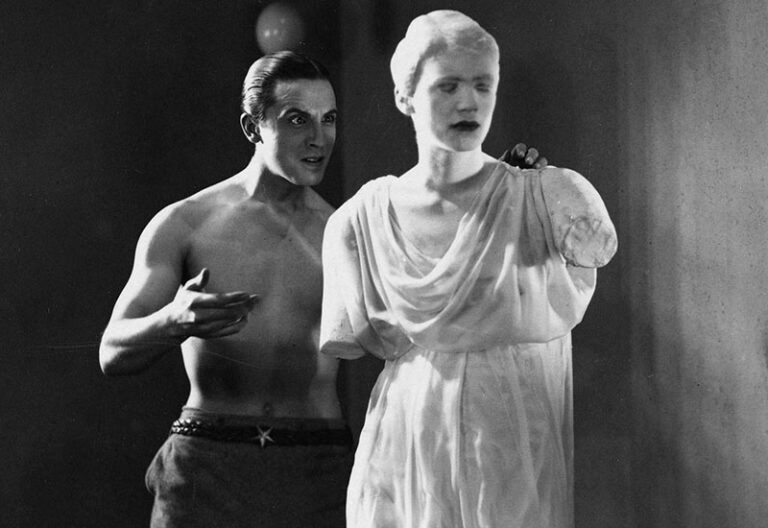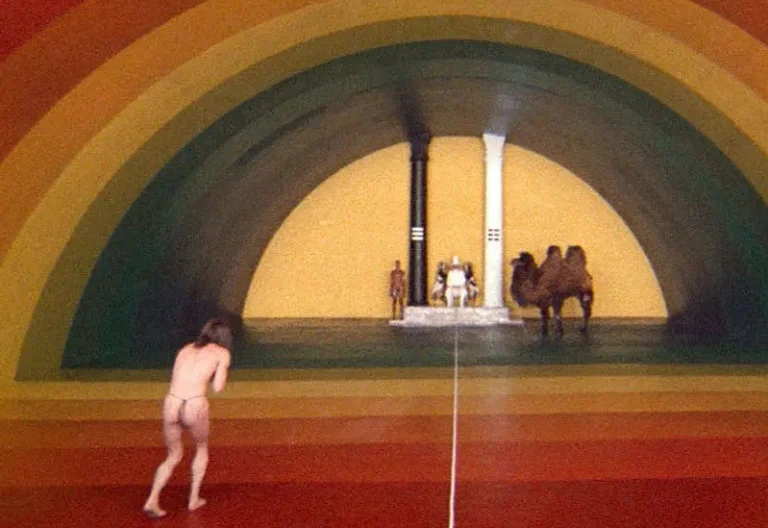a guide to absurdist film
Absurdist film is a genre that stems from the philosophical concept of absurdism, which suggests that life is inherently without meaning, purpose, or order, and that human beings must grapple with the chaos of existence. This philosophy was largely influenced by the works of existentialist philosophers like Albert Camus, who argued that the absurd arises from the human quest for meaning in a universe that offers none. In cinema, absurdism manifests as films that break from conventional storytelling, emphasizing the randomness and unpredictability of life, often with dark humor or satire.
Published by: CinemaWaves Team | Filed Under: Film Blog
Development of
Absurdist Film
Absurdist cinema emerged from the European avant-garde movements of the early 20th century, drawing influence from surrealist filmmakers like Luis Bunuel and the Dadaists, who aimed to challenge societal conventions and explore the boundaries of reality. Bunuel’s “Un Chien Andalou” (1929), co-directed with Salvador Dali, is considered one of the first absurdist films, known for its dreamlike imagery and disjointed narrative. Following this, the Theatre of the Absurd, as pioneered by playwrights such as Samuel Beckett and Eugene Ionesco, also heavily influenced absurdist cinema, with its depiction of human struggles in meaningless, repetitive, or chaotic scenarios.
During the post-World War II era, filmmakers began to explore the absurdity of war, bureaucracy, and societal structures, reflecting the sense of meaninglessness many felt in the wake of global conflict and political unrest. Stanley Kubrick’s “Dr. Strangelove” (1964) is a key example from this period, using satire to comment on the absurdity of nuclear warfare and Cold War politics. Similarly, Eastern European directors like Jan Svankmajer and the Czechoslovak New Wave began to incorporate absurdist themes into their work, blending surrealism with dark humor to critique authoritarian regimes.
In the 1960s and 70s, absurdist film gained more prominence, particularly with directors like Federico Fellini and New Wave’s Jean-Luc Godard. It continued to evolve, with directors like David Lynch bringing surreal, dreamlike elements into mainstream cinema with films like “Eraserhead” (1977) and “Mulholland Drive” (2001), which toy with reality and challenge viewers’ perception.

Themes and Style of Absurdist Film
Absurdist films typically challenge the viewer’s expectations by subverting traditional plot structures, utilizing surreal and fantastical elements, and presenting characters in exaggerated or nonsensical situations. The dialogue may be circular, actions might lack a clear cause and effect, and the overall message often highlights the futility of human existence.
Characters are frequently depicted as powerless, grappling with forces beyond their control or understanding. Directors of absurdist films often employ visual metaphors, nontraditional editing techniques, and non-linear narratives to reflect the chaotic and irrational nature of the world.
Best Examples of
Absurdist Films
“Un Chien Andalou” (1929) by Luis Bunuel: Silent short film, co-created with Salvador Dali, is a pioneering work of absurdist cinema. Known for its iconic, shocking imagery (such as the infamous scene of a woman’s eye being sliced), the film defies narrative logic and immerses viewers in a world of surrealism and absurdity.
“Dr. Strangelove” (1964) by Stanley Kubrick: Dark comedy masterpiece set during the Cold War, is an absurdist take on the potential for global destruction. The film explores the irrationality of military and political systems, presenting comedic characters in a nightmarish scenario of nuclear apocalypse. Its satire of the futility of human efforts to control such immense power captures the essence of absurdism.
“The Discreet Charm of the Bourgeoisie” (1972) by Luis Bunuel: Absurdist satire takes aim at the social elite, following a group of upper-class friends as they try – and fail – to have a meal together, encountering increasingly bizarre and surreal obstacles.
“Brazil” (1985) by Terry Gilliam: This sci-fi film is an absurdist take on bureaucratic life and totalitarian systems. The protagonist’s attempts to escape the nightmarish bureaucracy lead him into an increasingly surreal and hopeless reality.
“Eternal Sunshine of the Spotless Mind” (2004) by Michel Gondry: The film explores the absurdity of human relationships and memory. Its fragmented narrative and surreal visuals reflect the irrationality of trying to erase painful memories, highlighting absurdist themes of love, loss, and the human condition.
“The Lobster” (2015) by Yorgos Lanthimos: It presents a world where single people must find a romantic partner within 45 days or be transformed into an animal. The film’s dark humor, deadpan dialogue, and bizarre premise explore themes of love, societal pressure, and the absurdity of human relationships.
Absurdist Film in Contemporary Cinema
While traditional absurdist films may not dominate modern cinema, their influence is undeniable. Contemporary filmmakers like Greek Weird Wave’s Yorgos Lanthimos, continue to push the boundaries of absurdism by creating unsettling, darkly comedic worlds where characters must navigate scenarios governed by illogical or arbitrary rules.
Directors such as Quentin Dupieux and Charlie Kaufman also carry forward the absurdist tradition, blending surrealism with sharp critiques of modern life and the human condition. Absurdist cinema remains a powerful tool for challenging perception and evoking existential reflection, proving that its relevance still persists.
Refer to the main page for more educational insights on filmmaking and cinema history.
Experimental film, referred to as avantgarde cinema, is a genre that defies traditional storytelling and filmmaking techniques. It explores the boundaries of the medium , prioritizing…
A loosely defined, unconventional, movement of Greek cinema that surfaced in the late 2000s as a response to the country’s economic and social challenges. Characterized…
Surrealist cinema originated in the 1920s as an extension of the broader Surrealist art movement, which itself grew out of the Dada movement that arose during and after World…
The scandal of the 1973 Cannes Festival, director Jodorowsky’s flood of sacrilegious imagery and existential symbolism in The Holy Mountain is a spiritual quest for…
The 1960s was a tumultuous era of change and transformation across the globe, while in the former Yugoslavia, a unique and provocative film movement known as…
Postmodernist film emerged in the latter half of the 20th century, rooted in the broader cultural and philosophical movement of postmodernism. It started as a reaction…






